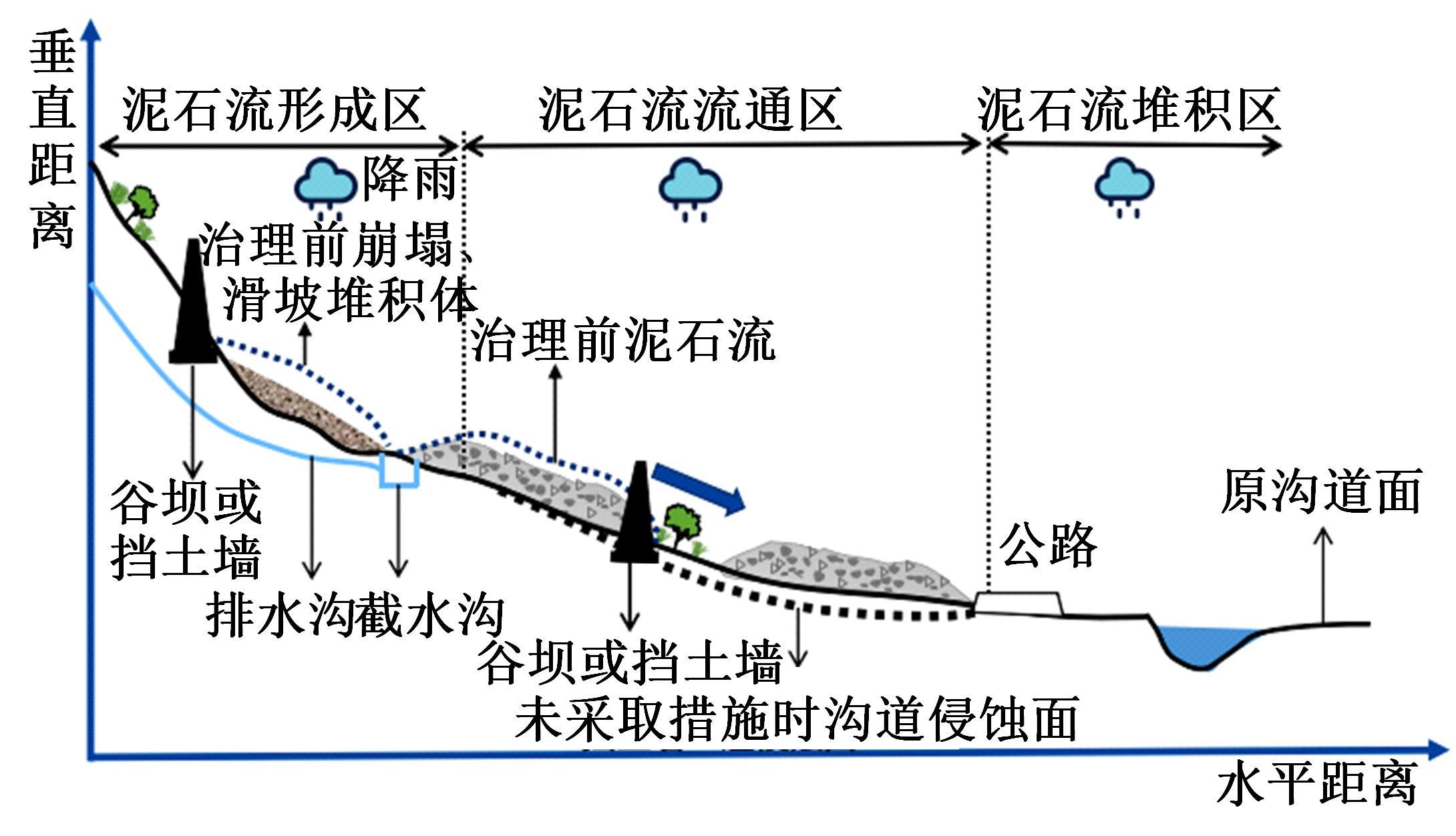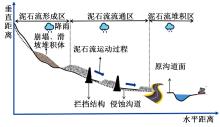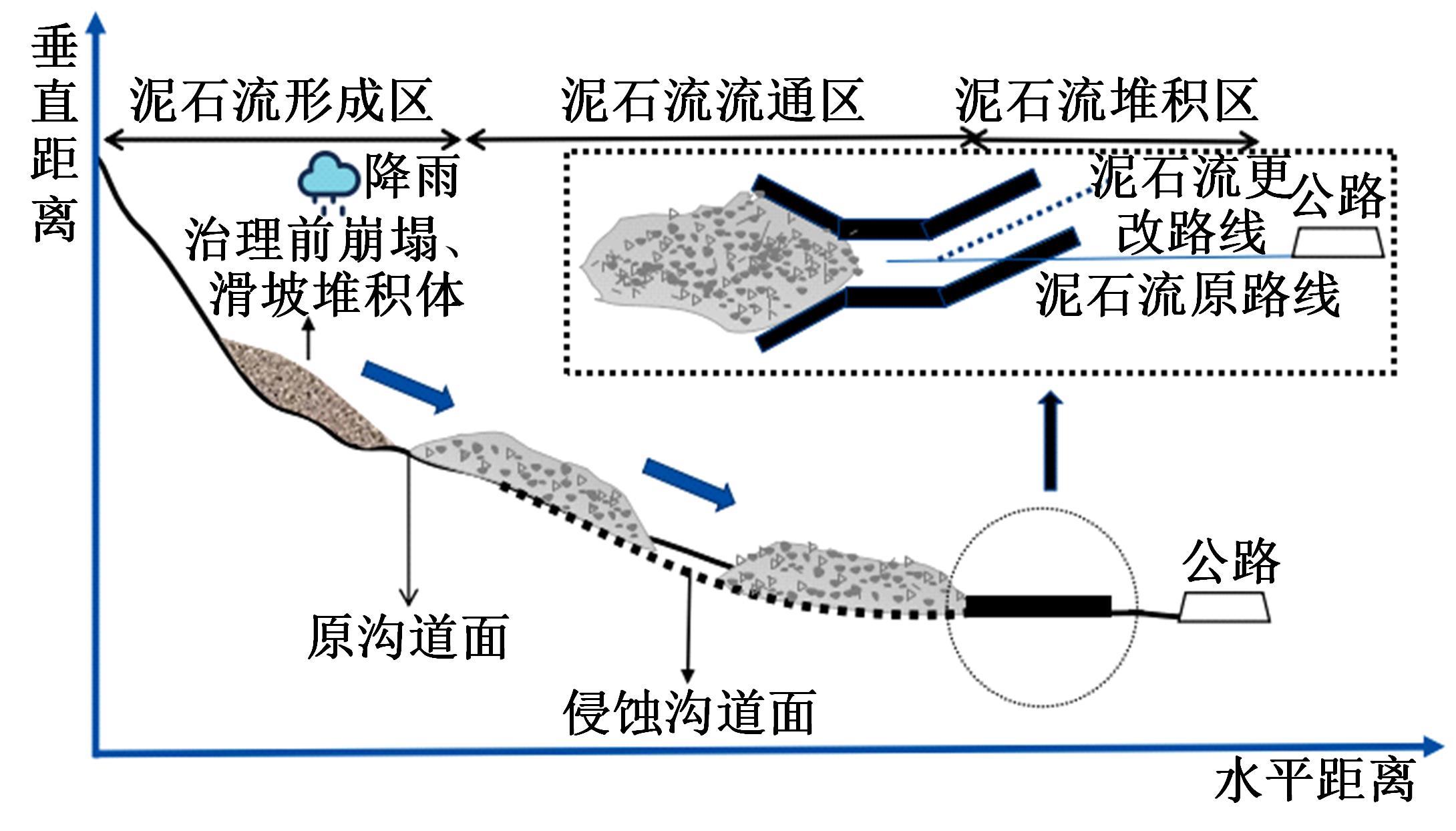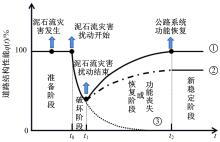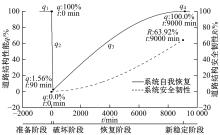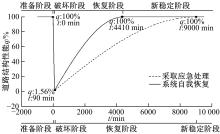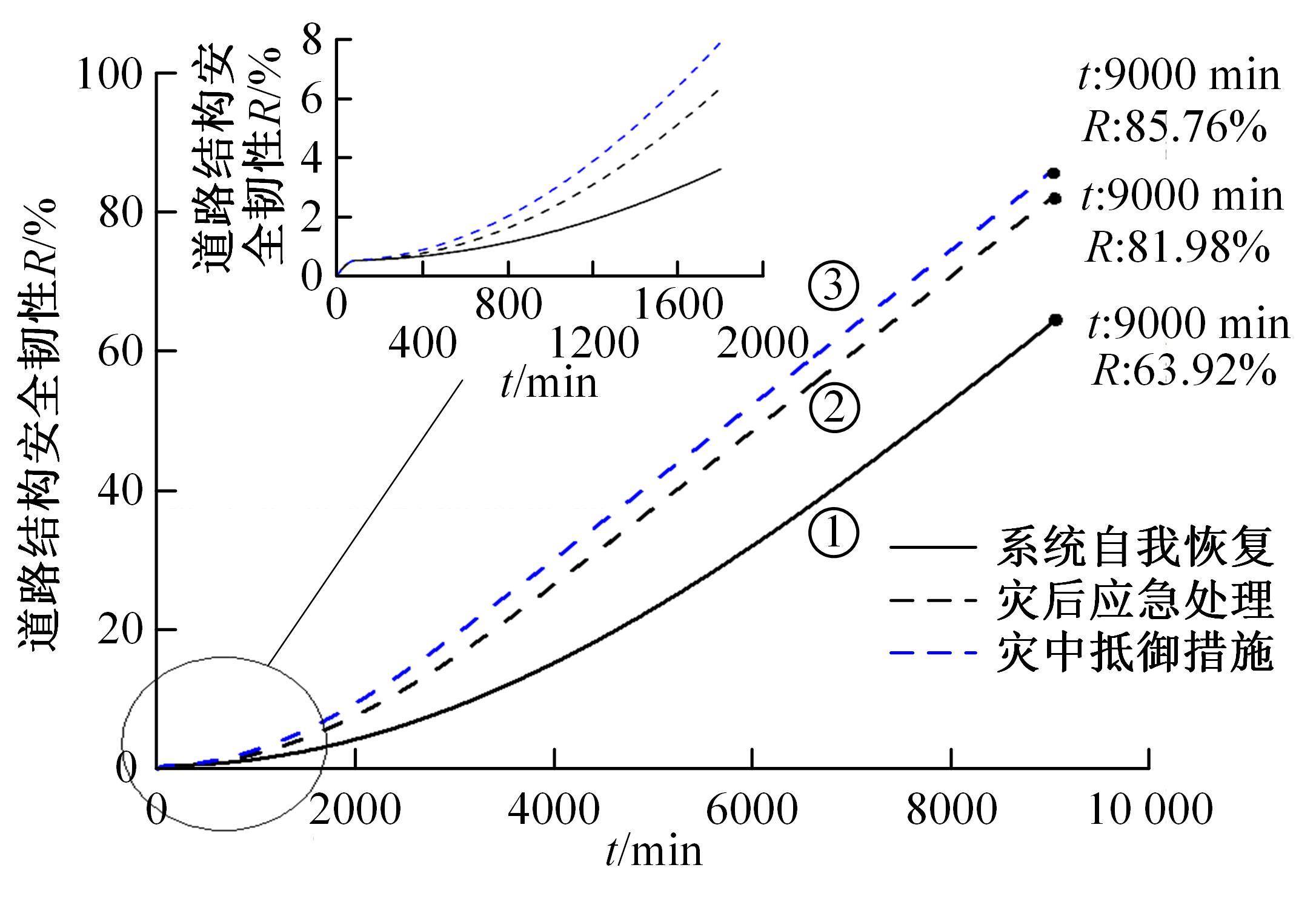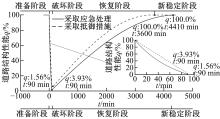Journal of Jilin University(Engineering and Technology Edition) ›› 2023, Vol. 53 ›› Issue (6): 1773-1781.doi: 10.13229/j.cnki.jdxbgxb.20230069
Toughness analysis and improvement of road structure under action of debris flow
Zhi-jia XUE1( ),Zhao-yang WANG1,Jiu-peng ZHANG1(
),Zhao-yang WANG1,Jiu-peng ZHANG1( ),Chang-gen YAN1,Zi-kai XU1,Ying-li ZHANG1,Xiao-ming Huang2,Tao Ma2
),Chang-gen YAN1,Zi-kai XU1,Ying-li ZHANG1,Xiao-ming Huang2,Tao Ma2
- 1.School of Highway,Chang'an University,Xi'an 710064,China
2.School of Transportation,Southeast University,Nanjing 211189,China
CLC Number:
- U491
| 1 | 刘坤. 我国基础设施整体水平跨越式提升[N]. 光明日报, 2022-09-27. |
| 2 | 黄琦, 谢涛, 陈欢欢, 等. 2020年8月甘肃武都群发泥石流基本特征及减灾建议[J]. 公路, 2022, 67(9): 30-37. |
| Huang Qi, Xie Tao, Chen Huan-huan, et al. Basic characteristics of mass debris flows in wudu, gansu province in august 2020 and suggestions for disaster reduction[J]. Highway, 2022, 67(9): 30-37. | |
| 3 | 马敏, 胡大伟, 舒兰, 等. 城市轨道交通网络韧性评估及恢复策略分析[J]. 吉林大学学报:工学版, 2023, 53(2): 396-404. |
| Ma Min, Hu Da-wei, Shu Lan, et al. Resilience assessment and recovery strategy analysis of urban rail transit network[J]. Journal of Jilin University (Engineering and Technology Edition), 2023, 53(2): 396-404. | |
| 4 | 殷凯. 城市交通网络韧性综合评估研究[D]. 北京: 北京交通大学交通运输工程学院, 2021. |
| Yin Kai. Research on comprehensive assessment of urban transport network resilience [D]. Beijing: School of Traffic and Transportation, Beijing Jiaotong University, 2021. | |
| 5 | Bruneau M, Chang S E, Eguchi R T. A framework to quantitatively assess and enhance the seismic resilience of communities[J]. Earthquake Spectra, 2003, 19(4): 733-752. |
| 6 | 唐少虎, 朱伟, 程光, 等. 暴雨内涝下城市道路交通系统安全韧性评估[J]. 中国安全科学学报, 2022, 32(7): 143-150. |
| Tang Shao-hu, Zhu Wei, Cheng Guang, et al. Assessment of urban road traffic system safety resilience under rainstorm and water logging[J]. Chinese Journal of Safety Science, 2022, 32(7): 143-150. | |
| 7 | Cimellaro G P, Reinhorn A M, Bruneau M. Seismic resilience of a hospital system[J]. Structure and Infrastructure Engineering, 2010, 6(1/2): 127-144. |
| 8 | 刘杰. 泥石流路基破坏机理与拦挡结构设计研究[D]. 重庆: 重庆交通大学交通运输工程学院, 2018. |
| Liu Jie. Research on damage mechanism of debris flow subgrade and design of retaining structure[D]. Chongqing: College of Transportation Engineering, Chongqing Jiaotong University, 2018. | |
| 9 | 王林峰, 唐红梅, 陈洪凯. 泥石流冲击作用下路基的毁损机制研究[J]. 公路, 2011(11): 31-35. |
| Wang Lin-feng, Tang Hong-mei, Chen Hong-kai. Research on damage mechanism of subgrade under debris flow impact[J]. Highway, 2011(11): 31-35. | |
| 10 | 沈志红. 泥石流堆积区对公路工程的影响[D]. 西安:长安大学公路学院, 2010. |
| Shen Zhi-hong. Impact of debris flow accumulation area on highway engineering[D]. Xi'an: College of Highway, Chang'an University, 2010. | |
| 11 | 胡涛. 汶川震区震后大型泥石流致灾机理及防治对策研究[D]. 成都: 成都理工大学地质勘察学院, 2017. |
| Hu Tao. Research on the disaster mechanism and prevention countermeasures of large-scale debris flow after the Wenchuan earthquake[D]. Chengdu: College of Geological Exploration, Chengdu University of Technology, 2017. | |
| 12 | 冯明硕. 干旱半干旱地区暴雨型稀性泥石流运动学特征及防治研究[D]. 西安:长安大学水资源与环境学院, 2007. |
| Feng Ming-shuo. Study on the kinematic characteristics and prevention of rainstorm type rare debris flow in arid and semi arid areas[D]. Xi'an: College of Water Resources and Environment, Chang'an University, 2007. | |
| 13 | 罗恒. 云南省元谋县城泥石流治理工程效果评价[D]. 成都:成都理工大学地质勘察学院, 2018. |
| Luo Heng. Effect evaluation of debris flow control project in yuanmou county, yunnan province[D]. Chengdu: College of Geological Exploration, Chengdu University of Technology, 2018. | |
| 14 | 陈娱. 大箐泥石流对桥墩的冲击动力作用及灾害治理措施研究[D]. 昆明: 昆明理工大学国土资源学院, 2017. |
| Chen Yu. Research on impact dynamic effect of daqing debris flow on piers and disaster control measures[D]. Kunming: College of Land and Resources, Kunming University of Science and Technology, 2017. | |
| 15 | 瞿华南. 考虑坝后淤积作用下的泥石流冲击拦挡坝动力响应研究[D]. 成都: 成都理工大学地质勘查学院, 2021. |
| Qu Hua-nan. Study on the dynamic response of debris flow impacting the retaining dam under the consideration of sedimentation behind the dam[D]. Chengdu: College of Geological Exploration, Chengdu University of Technology, 2021. | |
| 16 | 杨再智. 云南大盈江浑水沟泥石流防治工程效益分析[D]. 昆明: 云南大学生态与环境学院, 2021. |
| Yang Zai-zhi. Benefit analysis of debris flow control project in Hunshui gully of Daying River in Yunnan[D]. Yunnan: School of Ecology and Environment, Yunnan University, 2021. | |
| 17 | 张文涛. 泥石流防治岩土-生态工程综合治理效果分析与评价[D]. 北京: 中国科学院大学建筑与土木工程学院, 2021. |
| Zhang Wen-tao. Analysis and evaluation of comprehensive control effect of geotechnical ecological engineering for debris flow control[D]. Beijing: School of Architecture and Civil Engineering, University of Chinese Academy of Sciences, 2021. | |
| 18 | 熊木齐, 郭富赟, 崔志杰, 等. 甘肃省武都区马槽沟泥石流特征及其治理工程效应[J]. 兰州大学学报, 2015, 51(6): 831-836. |
| Xiong Mu-qi, Guo Fu-yun, Cui Zhi-jie, et al. Characteristics of debris flow in Machao valley, Wudu district, Gansu province and its control engineering effects[J]. Journal of Lanzhou University, 2015, 51(6): 831-836. | |
| 19 | 周海波, 陈宁生, 卢阳, 等. 泥石流沟谷坊坝群治理效应——以地震极重灾区北川县化石板沟为例[J]. 山地学报, 2012, 30(3): 347-354. |
| Zhou Hai-bo, Chen Ning-sheng, Lu Yang, et al. The harnessing effect of debris flow gullies and gufang dams—taking Huashiban Gully in Beichuan County, a severely earthquake stricken area, as an example[J]. Journal of Mountain Science, 2012, 30(3): 347-354. | |
| 20 | 李彪. G310线牛背至麦积公路泥石流灾害处治设计研[J]. 甘肃科技, 2018, 34(16): 39-40. |
| Li Biao. Research on design of debris flow disaster treatment for Niubei Maiji Highway of G310 Line[J]. Gansu Science and Technology, 2018, 34 (16): 39-40. | |
| 21 | 王天健, 胡桂胜, 陈宁生, 等. 泥石流单双边防护堤防治效果对比——以曾达沟为例[J]. 防灾减灾学报, 2022, 38(1): 1-8. |
| Wang Tian-jian, Hu Gui-sheng, Chen Ning-sheng, et al. Comparison of prevention and control effects of single and bilateral protective dikes for debris flow—taking Zengda valley as an example[J]. Journal of Disaster Prevention and Reduction, 2022, 38(1): 1-8. | |
| 22 | Nipa T J, Kermanshachi S. Resilience measurement in highway and roadway infrastructures: experts' perspectives[J]. Progress in Disaster Science, 2022, 14: No.100230. |
| 23 | Ouyang M, Dueñas-Osorio L, Min X. A three-stage resilience analysis framework for urban infrastructure systems[J]. Structural Safety, 2012, 36/37: 23-31. |
| 24 | 黄弘, 李瑞奇, 秦挺鑫, 等. 安全韧性城市评价模型与方法研究[M]. 北京: 清华大学出版社, 2021. |
| 25 | 陈洪凯, 唐红梅. 泥石流两相冲击力及冲击时间计算方法[J]. 中国公路学报, 2006, 19(3): 19-23. |
| Chen Hong-kai, Tang Hong-mei. Mud-rock flow of two phase impact force and impact time calculation method[J]. China Journal of Highway, 2006, 19(3): 19-23. | |
| 26 | 陇南发布. 陇南交通路况信息[DB/OL]. [2023-01-15]. |
| 27 | 梁梦辉, 向灵芝, 沈娜, 等. 白龙江流域水峪沟泥石流危险性分析[J]. 路基工程, 2022(6): 214-219. |
| Liang Meng-hui, Xiang Ling-zhi, Shen Na, et al. Hazard analysis of debris flow in Shuiyu valley of Bailong river basin[J]. Subgrade Engineering, 2022(6): 214-219. | |
| 28 | 高路. 四川省九寨沟县牙屯沟泥石流灾害防治研究[D].成都: 成都理工大学地质勘查学院, 2011. |
| Gao Lu. Research on the prevention and control of debris flow in Yatun gully, Jiuzhaigou county, Sichuan province[D]. Chengdu: College of Geological Exploration, Chengdu University of Technology, 2011. | |
| 29 | 刘传正, 苗天宝, 陈红旗, 等. 甘肃舟曲2010年8月8日特大山洪泥石流灾害的基本特征及成因[J]. 地质通报, 2011, 30(1): 141-150. |
| Liu Chuan-zheng, Miao Tian-bao, Chen Hong-qi, et al. Basic characteristics and causes of the catastrophic mountain torrents and debris flows on August 8, 2010 in Zhouqu, Gansu[J]. Bulletin Geological, 2011, 30(1): 141-150. |
| [1] | Guo-zhu CHENG,Lin SHENG,Hao ZHAO,Tian-jun FENG. Exclusive phase setting condition of signalized intersection based on risk analysis [J]. Journal of Jilin University(Engineering and Technology Edition), 2023, 53(7): 1962-1969. |
| [2] | Yong-ming HE,Shi-sheng CHEN,Jia FENG,Ya-nan WAN. Superhighway virtual track system based on high precision map [J]. Journal of Jilin University(Engineering and Technology Edition), 2023, 53(7): 2016-2028. |
| [3] | Rong-han YAO,Wen-tao XU,Wei-wei GUO. Drivers' takeover behavior and intention recognition based on factor and long short⁃term memory [J]. Journal of Jilin University(Engineering and Technology Edition), 2023, 53(3): 758-771. |
| [4] | Xue XIAO,Ke-ping LI,Bo PENG,Man-wei CHANG. Integrated lane⁃changing model of decision making and motion planning for autonomous vehicles [J]. Journal of Jilin University(Engineering and Technology Edition), 2023, 53(3): 746-757. |
| [5] | Min MA,Da-wei HU,Lan SHU,Zhuang-lin MA. Resilience assessment and recovery strategy on urban rail transit network [J]. Journal of Jilin University(Engineering and Technology Edition), 2023, 53(2): 396-404. |
| [6] | Jing WANG,Feng WAN,Chun-jiao DONG,Chun-fu SHAO. Modelling on catchment area and attraction intensity of urban rail transit stations [J]. Journal of Jilin University(Engineering and Technology Edition), 2023, 53(2): 439-447. |
| [7] | Song FANG,Jian-xiao MA,Gen LI,Ling-hong SHEN,Chu-bo XU. Traffic risk analysis of moving work zone on right lane of city expressway [J]. Journal of Jilin University(Engineering and Technology Edition), 2022, 52(8): 1786-1791. |
| [8] | Song-xue GAI,Xiao-qing ZENG,Xiao-yuan YUE,Zi-hao YUAN. Parking guidance model based on user and system bi⁃level optimization algorithm [J]. Journal of Jilin University(Engineering and Technology Edition), 2022, 52(6): 1344-1352. |
| [9] | Hong-feng XU,Hong-jin CHEN,Dong ZHANG,Qian-hui LU,Na AN,Xian-cai Geng. Fully⁃actuated signal timing technique for isolated signalized intersections in connected vehicle environment [J]. Journal of Jilin University(Engineering and Technology Edition), 2022, 52(6): 1324-1336. |
| [10] | Guo-zhu CHENG,Qiu-yue SUN,Yue-bo LIU,Ji-long CHEN. Cut⁃in behavior model based on game theoretic approach on urban roads [J]. Journal of Jilin University(Engineering and Technology Edition), 2022, 52(12): 2839-2844. |
| [11] | Heng-yan PAN,Wen-hui ZHANG,Bao-yu HU,Zun-yan LIU,Yong-gang WANG,Xiao ZHANG. Construction and robustness analysis of urban weighted subway⁃bus composite network [J]. Journal of Jilin University(Engineering and Technology Edition), 2022, 52(11): 2582-2591. |
| [12] | Zhuang-lin MA,Shan-shan CUI,Da-wei HU. Urban residents' low⁃carbon travel intention after implementation of driving restriction policy [J]. Journal of Jilin University(Engineering and Technology Edition), 2022, 52(11): 2607-2617. |
| [13] | Jing-xian WU,Hua-peng SHEN,Yin HAN,Min YANG. Residents' commuting time model under the nonlinear impact of urban built environment [J]. Journal of Jilin University(Engineering and Technology Edition), 2022, 52(11): 2568-2573. |
| [14] | Jie MA,Jia-jun HUANG,Jun TIAN,Yang-hui DONG. Simulation modeling of pedestrian target decision⁃making in evacuation process in transfer corridors of subway stations [J]. Journal of Jilin University(Engineering and Technology Edition), 2022, 52(11): 2600-2606. |
| [15] | Feng XUE,Chuan-lei HE,Qian HUANG,Jian LUO. Coordination degree of multimodal rail transit network [J]. Journal of Jilin University(Engineering and Technology Edition), 2021, 51(6): 2040-2050. |
|
||

